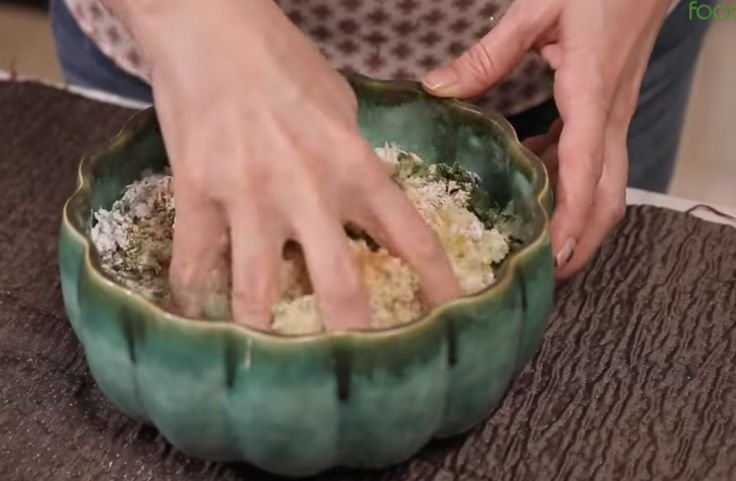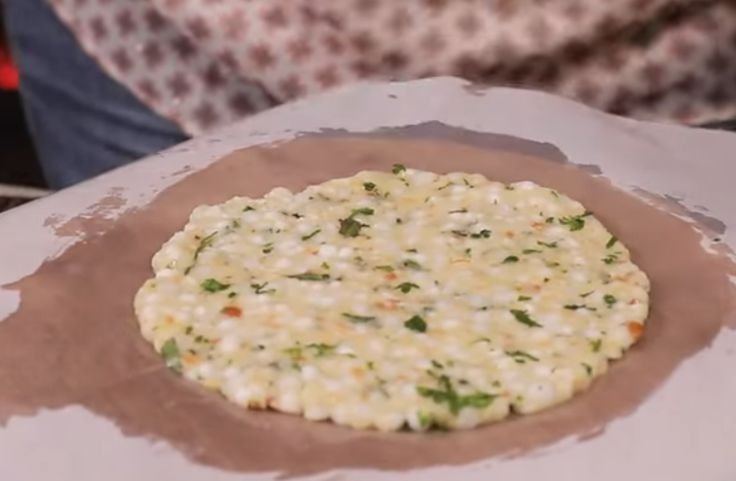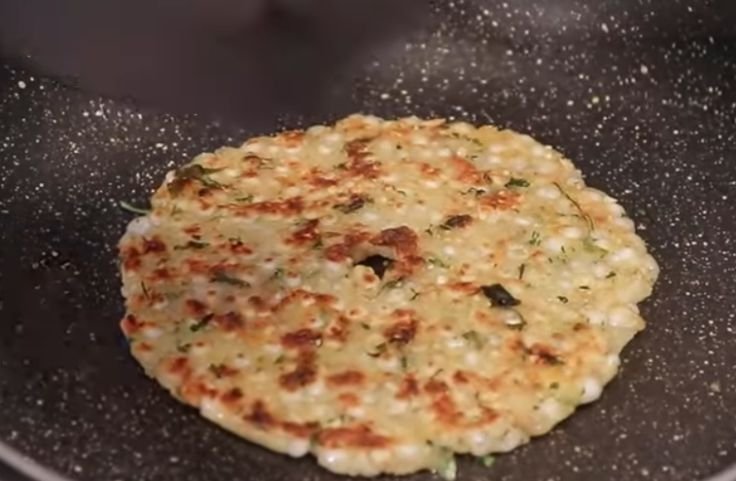Sabudana thalipeeth packs flavor, crunch, and energy into every bite. Here’s how to make it perfectly crisp, keep it light, and know what you’re eating with each serving.
When you prepare sabudana thalipeeth, you are making more than a snack.
You are carrying forward a tradition that has brought warmth and nourishment to countless households in Maharashtra.
This flatbread, made from sago pearls and simple spices, is a common choice during fasting days like Navratri, giving you steady energy without breaking dietary rules.
The process begins with soaking the pearls until soft, then mixing them with boiled potatoes, cumin, chilies, and fresh coriander.
Shaping the mixture into thin discs and cooking them until crisp on the outside gives you a wholesome dish with a tender center.
Each bite satisfies hunger while keeping you light.
Naturally gluten-free and rich in carbohydrates, sabudana thalipeeth is both filling and suitable for those with specific dietary needs.
Table of Contents
- What is Sabudana Thalipeeth?
- Ingredients You’ll Need
- How to Make Sabudana Thalipeeth (Step-by-Step)
- Serving Tips
- Common Mistakes to Avoid
- Conclusion
- Frequently Asked Questions
What is Sabudana Thalipeeth?
Sabudana thalipeeth is a traditional Maharashtrian flatbread made with soaked tapioca pearls or sabudana, mashed potatoes, and crushed peanuts, creating a balance of soft, chewy, and mildly crunchy textures.
It is most commonly prepared during fasting periods such as Navratri and Ekadashi, when grains are avoided, making it an ideal gluten-free and energy-rich alternative.
The peanuts provide a boost of protein, while spices like cumin, green chili, and fresh coriander add depth of flavor.
Pan-cooked until golden and crisp at the edges, this dish offers a wholesome bite that is both satisfying and nourishing, making it a popular choice for breakfast, snacks, or light meals during religious observances.
Related Posts
How to Make Sabudana Vada – This Crispy Indian Fasting Snack
Ingredients You’ll Need
To make sabudana thalipeeth that is full of flavor and energy, you will work with a few key ingredients.
Each one plays an important role in taste, texture, and nutrition.
Soaked Sabudana
Start with sabudana, also called tapioca pearls, soaked overnight until soft and plump.
This forms the base of the thalipeeth and gives it its signature chewy texture.
The soaking process ensures the pearls cook evenly and blend smoothly with the other ingredients.
Using properly soaked sabudana also prevents the thalipeeth from becoming dry or crumbly.
This step is essential for achieving the right consistency, making your flatbread light yet satisfying with every bite.
Boiled Potatoes
Boiled potatoes act as the natural binder that holds the mixture together without the need for refined flour.
They bring a mild, earthy taste that complements the sabudana while adding creaminess to the texture.
Their starch content helps keep the thalipeeth soft inside while allowing the outside to crisp up during cooking.
Freshly boiled potatoes work best, as they combine more evenly with the pearls and seasonings for a smooth, uniform dough.
Crushed Roasted Peanuts
Crushed roasted peanuts add a nutty depth that pairs beautifully with the gentle flavor of sabudana.
They bring a pleasant crunch to contrast the soft, chewy base and also increase the protein content of the dish.
Roasting the peanuts before crushing releases their natural oils and enhances their aroma.
This step makes a noticeable difference in flavor, giving the thalipeeth a rich, savory undertone that keeps each bite interesting.
Rock Salt
Rock salt, or sendha namak, is used during fasting periods as it aligns with traditional dietary rules.
It offers a cleaner, milder taste than table salt, blending well with the other spices without overpowering them.
This ingredient ensures the flavor profile remains balanced while honoring fasting customs.
Rock salt also contains trace minerals, adding a small nutritional benefit beyond its seasoning role.
Using it helps maintain the authenticity of the dish.
Green Chilies
Green chilies add a gentle heat and freshness that brightens the overall taste.
They can be adjusted to suit your spice preference, making the dish mild or more piquant.
Chopped finely, they spread evenly through the mixture so every bite carries a subtle kick without overwhelming the palate.
Along with flavor, chilies contribute vitamins and antioxidants, giving your thalipeeth a small boost in nutrition while keeping the taste lively.
Cumin and Coriander Seeds
Cumin and coriander seeds bring warmth and an earthy aroma that deepens the flavor of sabudana thalipeeth.
Lightly crushing them before use helps release their natural oils, making their taste more pronounced.
These spices also aid digestion, which is especially helpful during fasting.
Their presence turns a simple mixture of sabudana and potatoes into a more aromatic and layered dish, adding character to every bite.
Ghee or Oil
Ghee or oil is used for roasting the thalipeeth until the surface turns golden and crisp.
Ghee lends a richer flavor and aroma, while oil offers a lighter option.
The cooking fat keeps the inside moist while creating a pleasant crunch on the outside.
Choosing between ghee and oil allows you to adapt the recipe to your taste and dietary needs, ensuring the final dish is both satisfying and wholesome.
How to Make Sabudana Thalipeeth (Step-by-Step)
Making sabudana thalipeeth is simple when you follow a few clear steps.
Each stage helps you get the right texture, flavor, and crispness for this traditional fasting flatbread.
Soak the Sabudana
Rinse sabudana in water until it runs clear to remove starch. Soak in just enough water for 4 to 6 hours or overnight.
The pearls should turn soft but remain whole. This step is important because it keeps the mixture from becoming sticky.
Drain any extra water before moving to the next step, so the dough holds together properly without turning mushy.
Prepare the Dough

Transfer the soaked sabudana to a large bowl. Add boiled mashed potatoes for binding, roasted crushed peanuts for crunch, rock salt for seasoning, and chopped coriander for freshness.
Mix everything gently with your hands until well combined.
If the dough feels too dry, add a spoonful of water, but keep it firm so the thalipeeth shapes easily without breaking.
Shape the Thalipeeth

Divide the dough into small balls. Grease a banana leaf or a clean plastic sheet with a drop of oil to prevent sticking.
Place one dough ball in the center and flatten it with your fingers or palms to about a quarter-inch thick.
This even thickness ensures proper cooking and prevents raw spots inside while keeping the edges crisp.
Cook Until Crisp

Heat a flat pan over medium flame and lightly grease it with oil or ghee.
Place the shaped thalipeeth on the pan and cook each side for about three to four minutes until golden brown.
Flip gently to avoid breaking, adding a little more oil if needed.
Once done, place them on paper towels to absorb excess oil before serving hot.
Serving Tips
Sabudana thalipeeth can fit into many meals, and the way you serve it can change its taste and feel. These ideas will help you enjoy it in different ways.
Pair with Yogurt
Serve sabudana thalipeeth with a bowl of fresh yogurt. The mild tang and creamy texture balance the crispy edges and soft center, creating a smooth and refreshing bite.
This pairing works especially well on warm days, as yogurt cools the palate and complements the earthy flavors of the thalipeeth without overpowering them.
You can even sprinkle a little cumin powder on the yogurt for extra aroma and taste.
Add Green Chutney
Fresh green chutney made from coriander, mint, chilies, and lemon juice gives sabudana thalipeeth a lively, zesty twist.
The sharp, herbal notes lift the mild base flavors, and the slight heat from the chilies keeps each bite interesting.
You can make the chutney mild or spicy depending on your taste, making it a great option when you want more flavor without heavy sides.
Enjoy Plain
Eating sabudana thalipeeth on its own lets you fully appreciate its texture and flavor.
The crisp outer layer contrasts with the soft, chewy middle, creating a satisfying mouthfeel.
This simple serving style is perfect when you want a quick snack during fasting days or a light bite in between meals.
A cup of hot tea or coffee makes a good companion for this plain version.
Serve with Curry or Soup
Sabudana thalipeeth can replace regular bread in a main meal. Pair it with vegetable curry for a wholesome plate, or dip it into a hot bowl of tomato or spinach soup.
The crispy base soaks up the flavors, turning every mouthful into a hearty combination of textures and tastes.
This pairing also adds more variety to fasting-friendly meal plans.
Common Mistakes to Avoid
Making sabudana thalipeeth at home is simple when you pay attention to a few details.
Avoiding these mistakes will help you get the right texture, flavor, and cooking results every time.
Over Soaking the Sabudana
Soaking sabudana too long makes the pearls mushy, which can cause the dough to fall apart while cooking.
For the right consistency, rinse the pearls well and soak them in just enough water to cover them. Two to four hours is usually enough.
Drain any leftover water before mixing with other ingredients so the dough stays firm and easy to shape.
Using Raw Peanuts
Raw peanuts can make your thalipeeth taste flat. Roasting the peanuts brings out a deeper flavor and adds crunch to each bite.
Roast them until golden, then grind into a coarse powder.
This not only improves the taste but also blends well with the soft texture of the sabudana and potatoes, creating a better balance in every mouthful.
Making the Thalipeeth Too Thick
If the thalipeeth is rolled too thick, the center can stay undercooked while the outside becomes overly crisp.
Aim for a uniform thickness of about one-fourth inch. This helps the heat cook through evenly and gives you the perfect contrast between the crispy edges and the soft inside.
Taking this step also makes flipping easier and prevents breakage while cooking.
Conclusion
Sabudana thalipeeth is more than a fasting recipe; it’s a wholesome dish you can enjoy any day for its taste and texture.
By using well-soaked sabudana, roasted peanuts, and evenly rolled dough, you get flatbreads that are crisp outside and soft inside.
Pair them with yogurt, chutney, or light curry for a balanced meal, or enjoy them plain with tea for a quick snack.
Since it is naturally gluten-free and made with simple ingredients, it suits both traditional fasting and modern dietary needs.
Whether you cook it fresh for breakfast or prepare it ahead for busy days, this recipe fits easily into your routine.
With just a few mindful steps, you can make sabudana thalipeeth that delivers flavor, energy, and satisfaction in every bite.
Frequently Asked Questions
Can I make sabudana thalipeeth without potatoes?
Yes, you can replace potatoes with boiled yams or grated raw banana. They help bind the mixture and keep it vrat-friendly and gluten-free.
How long can I store sabudana thalipeeth dough?
You can store the sabudana thalipeeth dough in the fridge for up to 24 hours in an airtight container. Bring to room temperature before use.
Is it sabudana thalipeeth good for weight loss?
Sabudana thalipeeth is calorie-dense and high in carbs, so it’s not ideal for weight loss. Use less oil and smaller portions if including it.
Can I freeze sabudana thalipeeth?
Yes, you can freeze cooked thalipeeth. Let them cool completely, wrap individually, and freeze for up to a month. Reheat on a pan before serving.
References

Chimeremeze Emeh is a writer and researcher passionate about Africa’s most transformative root crop—cassava. Through his work at cassavavaluechain.com, he explores the entire cassava industry, from cultivation and processing to its diverse applications in food, health, and industrial use.
He also writes for palmoilpalm.com, where he shares his extensive experience and deep-rooted knowledge of palm oil, covering red palm oil, palm kernel oil, and refined products. His work there reflects his lifelong connection to agriculture and his commitment to promoting sustainable value chains in Africa.
Driven by curiosity and purpose, Chimeremeze aims to shed light on how cassava continues to empower communities, strengthen food systems, and link traditional farming wisdom with modern innovation.

